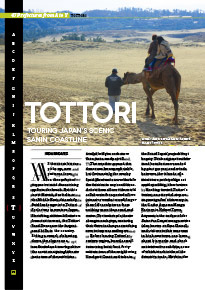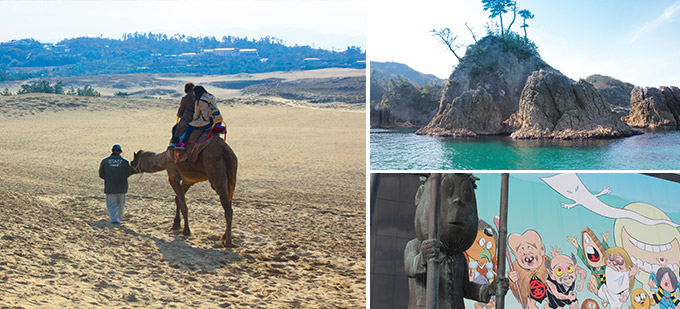Home > Highlighting JAPAN >Highlighting Japan January 2015> 47 Prefectures from A to Y
Highlighting JAPAN

47 Prefectures from A to Y
Tottori
Touring Japan’s Scenic Sanin Coastline

As the ocean breeze picks up, new patterns form on the surface of expansive sand dunes rising up from the beach. But this is not Hawaii, Australia or the Middle East; this subtly fluid landscape is in Tottori Prefecture in western Japan. Stretching sixteen kilometers from east to west, the Tottori Sand Dunes are the largest sand hills in the country. Riding a camel, slaloming down the slopes on a sandboard and soaring above the scene on a paraglider are just some of the activities available if you seek more than just a sandy stroll.
The weather around the dunes can be unpredictable, but fortunately the nearby Sand Museum is a worthwhile destination in any conditions. Artists from all over the world collaborate for a period of two intensive weeks to craft larger-than-life sculptures from nothing more than sand and water. The museum’s theme changes each year, ensuring that there is always something new to impress audiences.
Before leaving Tottori’s eastern region, board a small excursion boat for a forty-minute tour of the neighboring Uradome Coast and take in the Sea of Japan’s windswept beauty. The boat passes white-sand beaches surrounded by pine groves, and winds between the islands of a miniature archipelago set amid sparkling, clear waters.
Heading toward Tottori’s center, an essential stop on any manga fan’s itinerary is the Gosho Aoyama Manga Factory in Hokuei Town. Aoyama is the author of the Detective Conan manga series (also known as Case Closed), and visitors to this museum in his hometown can learn about his works and check out interactive exhibits, some of which teach tricks of the detective trade. Much to the delight of fans, Aoyama himself sometimes visits the museum.
Another point of interest for manga enthusiasts can be found on the western side of Tottori.
Sakaiminato City is the home of manga artist Shigeru Mizuki, most notable for producing the GeGeGe no Kitaro series. This popular series is beloved by Japanese people of all ages for its wonderfully strange yokai—supernatural monsters—many derived from Japanese folklore, and more cute than scary.
Mizuki Shigeru Road is lined with over 150 bronze statues depicting various yokai, while manga characters can be spotted on public signs, street lights and even local taxis. The road extends eight hundred meters from JR Sakaiminato Station, culminating at the Mizuki Shigeru Museum, which details the author’s life and introduces a full lineup of Japan’s mythical creatures.
Sakaiminato’s sizable fishing port makes it an excellent and affordable place to sample fresh seafood from the Sea of Japan. In the winter, Tottori’s fishermen haul in the largest crab fishing net in the country to catch the meaty, flavorful Matsuba crabs. Matsuba crabs are recognized as some of the best crabs in Japan. When in season, you’ll find Matsuba crab on the menu at conveyor belt sushi shops such as the one in JR Sakaiminato Station, or available whole at the popular Karoichi fish market in Tottori City.
Exploring the prefecture’s three main regions may seem daunting without wheels, but there is a convenient way. The prefectural government is sponsoring a special year-round tourist taxi service: travelers can hire a taxi from Tottori Station to a destination of their choice for up to three hours for just a thousand yen.
With fresh local food to sample, intriguing manga characters to meet and unspoiled, diverse nature in the form of sand dunes, beaches, hot springs and mountains to explore, Tottori offers a singular travel experience. Visiting the prefecture is definitely something you should consider.
© 2009 Cabinet Office, Government of Japan






